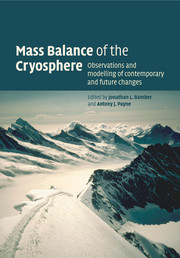Book contents
- Frontmatter
- Contents
- List of contributors
- Foreword
- Preface
- 1 Introduction and background
- Part I Observational techniques and methods
- Part II Modelling techniques and methods
- 5 Modelling land-ice surface mass balance
- 6 Modelling land-ice dynamics
- 7 Modelling the dynamic response of sea ice
- Part III The mass balance of sea ice
- Part IV The mass balance of the ice sheets
- Part V The mass balance of ice caps and glaciers
- Index
- References
7 - Modelling the dynamic response of sea ice
Published online by Cambridge University Press: 16 October 2009
- Frontmatter
- Contents
- List of contributors
- Foreword
- Preface
- 1 Introduction and background
- Part I Observational techniques and methods
- Part II Modelling techniques and methods
- 5 Modelling land-ice surface mass balance
- 6 Modelling land-ice dynamics
- 7 Modelling the dynamic response of sea ice
- Part III The mass balance of sea ice
- Part IV The mass balance of the ice sheets
- Part V The mass balance of ice caps and glaciers
- Index
- References
Summary
Introduction
The dynamical response of sea ice to climate change depends on a complex interplay between mechanical and thermodynamic processes driven by radiation, temperature, wind and oceanic forcing. Because of ice deformation, a typical 100 km2 patch of sea ice will contain a variety of ice thicknesses. These thicknesses range from open water to very thick ice, including pressure ridges extending possibly 30 m or more below the surface. On top of this matrix there is often a relatively thin snow cover. Although thin, this snow cover can cause substantial insulation of the ice and reduce its growth rate.
While the main driving forces that move this ice cover come from wind and currents, ice does not just move as a passive tracer. Instead, ice has a motion and, more notably, deformation that is significantly affected by the ice interaction. Far from shore, the effects of interaction are more subtle, but still considerable in that excessive ice buildup is prevented by ice pressure. In addition, deformation typically takes place in the form of long intersecting leads; a fracturing pattern that is common in the brittle failure of many materials. From models and observation, ice pressure is comparable in magnitude to the buildup of surface pressure in the ocean by sea-surface tilt. Ice stresses averaged over the ice thicknesses that are typically used in large-scale models, for example (Hibler, 2001), are of the order of 2–5 × 104 N/m2, which is approximately equivalent to the bottom pressure of a 2–5 m high column of water.
- Type
- Chapter
- Information
- Mass Balance of the CryosphereObservations and Modelling of Contemporary and Future Changes, pp. 227 - 334Publisher: Cambridge University PressPrint publication year: 2004
References
- 8
- Cited by



